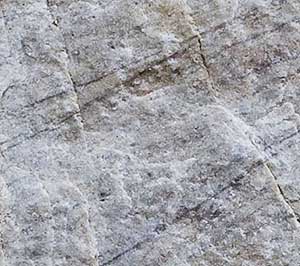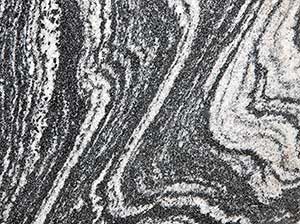| Types of Igneous Rocks |
 |
| Tintic Quartzite. |
Metamorphic means 'changed'. When a rock has been affected by metamorphic processes it has changed from one kind of rock to another. Metamorphic rocks can begin as igneous, sedimentary or other metamorphic rocks. They form when any kind of rock is exposed to high heat and high pressure over a long period of time. Extreme conditions like these for long periods can develop deep within the crust or where tectonic plates collide.
All metamorphic rocks have one thing in common, time. The longer a rock is exposed to one or all of the metamorphic stresses the more metamorphosed it becomes.
The creation of metamorphic rocks never involves melting the original rock. If these stresses do melt the original rock, an igneous rock is created. Metamorphic rocks change in the solid state by replacement or rearrangement of molecules. These changes are brought about by squishing, folding, and heating without ever melting!
Classifying metamorphic rocks is sometimes more difficult than identifying igneous or sedimentary rocks because of the various results of the varying stresses that affect them. The important thing to remember is the different stresses that can affect any rock can turn it into a metamorphosed rock.
 |
| Amitsoq Gneiss |
Foliated vs. Non-foliated
Two easy metamorphic classifications are: foliated and non-foliated. Foliation describes the texture (how the rock looks) of metamorphic rocks. It has to do with the way minerals are aligned in a rock. When rock is subject to extreme pressure grains will squish in the 'Y" plane of the pressure. Elongate or flat grains, such as mica, will align themselves parallel with each other in the 'Y" direction.When minerals line up parallel to each other, the rock shows a tendency to split along a plane created by those parallel grains. This is called rock cleavage, or slate cleavage, named for the fine-grained metamorphic rock slate which demonstrates this phenomenon. Sometimes minerals will not only align themselves in parallel directions, but will also segregate into bands of differing composition. This happens when rocks are subjected to the most intense heat and pressure they can stand without melting. A common example of the result of this phenomenon is gneiss. Slate, schist and gneiss are all foliated metamorphic rocks.
Non-foliated metamorphic rocks do not have a platy or sheet-like structure. There are several ways that non-foliated rocks can be produced. Some rocks, such as limestone are made of minerals that are not flat or elongate. No matter how much pressure you apply, the grains will not align! Another type of metamorphism, contact metamorphism, occurs when hot igneous rock intrudes into some pre-existing rock. The pre-existing rock is essentially baked by the heat, changing the mineral structure of the rock without addition of pressure.